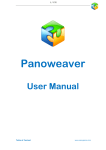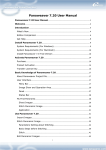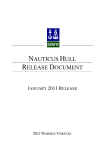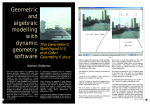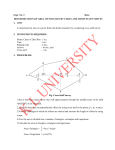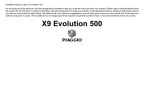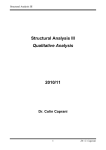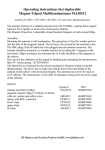Download LashCon IMO - User Guide
Transcript
LASHCON™ IMO USER GUIDE BY DET NORSKE VERITAS Version: 9.0 Date: 2003-12-08 1 General 1.1 Introduction LASHCONTM is a MS EXCEL based calculation tool for evaluation of semi- and non-standardised securing arrangements. The program calculates accelerations and balance of forces in semi- and non-standardised lashing arrangements in accordance with annex 13 to the Code of Safe Practice for Cargo Stowage and Securing (the CSS code) from IMO. 1.2 System requirements LASHCONTM requires Microsoft Windows version 3.1 or later, with Microsoft Excel 5.0 installed. Resources needed to run Microsoft Excel 5.0 are described in “Microsoft Excel User’s Guide”. 1.3 User requirements The user should be familiar with Microsoft products such as Excel and Word. This includes the use of mouse pointer. NOTE: The decimal separator may differ from the examples given in this booklet. Normally either “.” or “,” is used. 2. User guide 2.1 Input sequence 1. Once LASHCONTM has been started, the following screen picture will appear: 2. Input cells are marked white in LASHCONTM. Not all input cells are necessary for successful computation. Ship name and identification is solely for user reference. Vessel main particulars are used for acceleration computation and must be filled in before proceeding. See 2.2 Input Data for details. 3. After successful completion of the input data, click on the button “Next Page >>” proceed to the “Cargo and lashing data sheet”. The following picture will then appear: For help on input data, press the “?” button to the right of the respective input. The input parameters are the same as explained in “Code of Safe Practice for Cargo Stowage and Securing Annex 13. 4. Fill in the in the “Input of cargo unit data” field. 5. Select the “Cargo unit stowage position" (vertical and longitudinal) by using the drop-down selection boxes in the upper right corner of the screen. 6. Select the desired method of calculation. - Advanced calculation, see 2.3 Calculation Methods - Alternative calculation, see 2.3 Calculation Methods 7. Give the applicable lashing particulars - MSL of lashing. [kN] - Lashing direction for drop down boxes. - Vertical securing angle [deg] - Horizontal securing angle [deg] (Alternative method only.) - Horizontal securing point distance [m] 8. Calculation results are shown in the yellow area. “Actual forces” is the forces acting on the cargo unit due to the “Accelerations” at the given lashing position. “Securing capacity” is the accumulated lashing forces from applied lashings. If sufficient number of lashings is applied, compliance will be shown by “OK” in red fonts to the right of each capacity. 9. Acceleration data for the whole ship can be extracted from the “Tables and graphs” sheet. This can be accessed by either pressing the “Show graph >>” button or by pressing the “Tables and graphs” tab. Chart and table showing the accelerations along the ship length, based on the annex 13 to the IMO CSS code. 2.2 Input data Main ship data: Lpp - Length between perpendiculars in meters [m] B - Ship breadth in meters [m] V - Ship speed in knots [knots] GM - Ship GM value in meters [m] Main cargo data: m - Mass of cargo unit in tonnes [ton] µ - Coefficient of friction [ - ] Aw - Wind exposed area in square meters. [m2] As - Sea exposed area, 2 meters above BL, in meters. [m2] a - Lever arm of tipping, i.e. height of cargo unit CG above deck, in meters. [m] b - Lever arm of stableness in meters. [m] PORT STBD Fy CG c2 a b Tipping axis Advanced calculation, lashing parameters: MSL - Max securing load [kN] α - Vertical securing angle [degrees] d - Lever arm of securing force [m] Alternative calculation, lashing parameters: MSL - Max securing load [kN] α - Vertical securing angle [degrees] β - Horizontal securing angle [degrees] d - Lever arm of securing force [m] (See Advanced Calculation, lashing parameters) 2.3 Calculation methods Advanced calculation method The advanced method is based on force equilibrium of internal inertia forces and external lashing forces. Additionally, the risk of tipping is evaluated on basis of moment equilibrium. Forces due to wind, sea and friction are accounted for. Elastic characteristics of lashings are not included. In advanced calculations only the vertical angle of lashings, α, is included. Calculated strength of lashing, CS, is MSL / 1.5. For detailed theory outline, please refer to CSS, Annex 13. Alternative calculation method The alternative calculation method is based on force equilibrium of internal inertia forces and external lashing forces. Additionally, the risk of tipping is evaluated on basis of moment equilibrium. Forces due to wind, sea and friction are accounted for. Elastic characteristics of lashings are not included. The alternative method accounts for both the vertical of lashings, α, and horizontal angle of lashing β . The alternative method approach is regarded as more accurate than the advanced method. Hence the utilization of lashing strength is higher. Calculated strength of lashing, CS, is MSL / 1.35. Which calculation method to choose? The alternative calculation method is the most sophisticated with respect to force equilibrium. Hence, the allowable usage of the MSL is slightly higher. This method is therefore recommended. It should be noted that none of the calculation methods includes the elastic properties of the lashings. It is therefore important that the cargo unit is lashed with lashings of same type, with approximate equal elasticity. Lahing ropes and chains should not be combined. It is recommended to keep the lashings of approximately same lengths. 2.4 Special features of Lashcon IMO Stack function: LASHCONTM offers the possibility of saving your results in a stack. Lashing results, together with basic input is saved in a compact form in a table. In this way, the effect of different lashing arrangements or stowing positions can be compared in an easy manner. Stack buttons: “Save to stack”: Current lashing data and results are saved to the stack. “Clear last”: Removes the last entry in the stack. “Clear stack”: Removes the contents of the entire stack. “Show stack”: Shows the stack. 2.5 Program assumptions The calculation of accelerations and evaluation of lashing arrangements is based on the method described in annex 13 to the CSS code. For details on theory for evaluation of forces, please refer to CSS Annex 13. The following assumptions are directly quoted from the code: A vertical securing angle α greater than 60º will reduce the effectiveness of this particular securing device in respect of sliding of the unit. Disregarding of such devices from the balance of forces should be considered, unless the necessary load is gained by the imminent tendency to tipping or by a reliable pre-tensioning of the securing device and maintaining the pre-tension throughout the voyage. Any horisontal securing angle, i.e. deviation from the transverse direction should not exceed 30º, otherwise an exclusion of this securing device from the transverse sliding balance should be considered. LASHCONTM applies to lashing arrangements with vertical securing angles in the range according to table 5 in annex 13, i.e. -30º ≤ α ≤ 90º. Lashing angles outside this range may give corrupt results. In case such angle is given the program will give the following warning: α < -30° or α > 90° : Warning! Securing angle outside range stated in annex 13. The acceleration figures shown in table 3 in annex 13 are basis for the calculation of accelerations in LASHCONTM, and apply in principle to ships with 50 m ≤ L ≤ 200 m, 9 kn ≤ V ≤ 24 kn and B/GM ≥ 7. In LASHCONTM, however, the accelerations have been extrapolated by means of power series to apply for ships with L > 30 m, and speed up to 25 knots. The B/GM has been extrapolated to apply down to B/GM = 4. LASHCONTM does not calculate transverse accelerations if B/GM < 4. If input parameters are outside the applicable range, the following warnings will appear: L > 200 m : Warning! L > 200. Accelerations are extrapolated outside the range given in annex 13! B/GM < 7 : Warning! B/GM < 7. Accelerations are extrapolated outside the range given in annex 13! B/GM < 4 : Warning! B/GM < 4. Transverse accelerations are not calculated! V > 25 kn: Warning! V > 25 kn. Accelerations are not calculated! Explanation of variables is given in the Help-function in LASHCONTM. A complete explanation of variables involved and a full set of assumptions may be found in annex 13.








